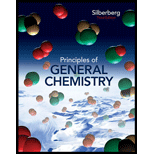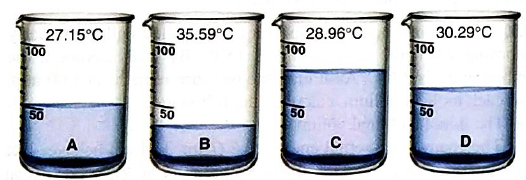
Principles of General Chemistry
3rd Edition
ISBN: 9780073402697
Author: SILBERBERG, Martin S.
Publisher: McGraw-Hill College
expand_more
expand_more
format_list_bulleted
Textbook Question
Chapter 6, Problem 6.65P
Four 50.-g sample of different liquids are placed in separate beakers at

Expert Solution & Answer
Want to see the full answer?
Check out a sample textbook solution
Students have asked these similar questions
If we assume a system with an anodic overpotential, the variation of n as a function
of current density:
1. at low fields is linear 2. at higher fields, it follows Tafel's law
Obtain the range of current densities for which the overpotential has the same value
when calculated for 1 and 2 cases (maximum relative difference of 5% compared to
the behavior for higher fields).
To which overpotential range does this correspond?
Data: i = 1.5 mA cm², T = 300°C, B = 0.64, R = 8.314 J K1 mol-1 and F = 96485 C mol-1.
Answer by equation please
Some of the theories used to describe interface structure can be distinguished by:1. the measured potential difference.2. the distribution of ions in solution.3. the calculation of charge density.4. the external Helmoltz plane.
Chapter 6 Solutions
Principles of General Chemistry
Ch. 6 - Prob. 6.1PCh. 6 - An adiabatic process is one that involves no heat...Ch. 6 - Name a common device used to accomplish each...Ch. 6 - Prob. 6.4PCh. 6 - A system receives 425 J of heat from and delivers...Ch. 6 - A system releases 255 cal of heat to the...Ch. 6 - Prob. 6.7PCh. 6 - Prob. 6.8PCh. 6 - The nutritional calorie (Calorie) is equivalent to...Ch. 6 - Classify the following processes as exothermic or...
Ch. 6 - Why can we measure only changes in enthalpy, not...Ch. 6 - Draw an enthalpy diagram for a general exothermic...Ch. 6 - Prob. 6.13PCh. 6 - Prob. 6.14PCh. 6 - Prob. 6.15PCh. 6 - Write a balanced equaĂ¼on and draw an approximate...Ch. 6 - Write a balanced equation and draw an approximate...Ch. 6 - The circles represent a phase change at constant...Ch. 6 - The scenes below represent a physical change...Ch. 6 - What data do you need to determine the specific...Ch. 6 - Is the specific heat capacity of a substance an...Ch. 6 - Find q when 22.0 g of water is heated from 25.0C...Ch. 6 - Prob. 6.23PCh. 6 - A 295-g aluminum engine part at an initial...Ch. 6 - A 27.7-g sample of the radiator coolant ethylene...Ch. 6 - Two iron bolts of equal mass-one at 100.C, the...Ch. 6 - Prob. 6.27PCh. 6 - When 155 mL of water at 26C is mixed with 75 mL of...Ch. 6 - Prob. 6.29PCh. 6 - Prob. 6.30PCh. 6 - Prob. 6.31PCh. 6 - When 25.0 mL of 0.500MH2SO4 is added to 25.0 mL of...Ch. 6 - Would you expect O2(g)20(g) to have a positive or...Ch. 6 - Is H positive or negative when 1 mol of water...Ch. 6 - Prob. 6.35PCh. 6 - Consider the following balanced thermochemical...Ch. 6 - When 1 mol of NO(g) forms from Its elements, 90.29...Ch. 6 - Prob. 6.38PCh. 6 - Liquid hydrogen peroxide, an oxidizing agent in...Ch. 6 - Prob. 6.40PCh. 6 - Most ethylene (C2H4), the starting material for...Ch. 6 - Prob. 6.42PCh. 6 - Prob. 6.43PCh. 6 - Calculate H for Ca(s)+12O2(g)+CO2(g)CaCO3(s) Given...Ch. 6 - Calculate H for 2NOCl(g)N2(g)+O2(g)+Cl2(g) given...Ch. 6 - Write the balanced overall equation (equation 3)...Ch. 6 - Write the balanced overall equation (equation 3)...Ch. 6 - Diamond and graphite are two crystalline forms of...Ch. 6 - Prob. 6.49PCh. 6 - Prob. 6.50PCh. 6 - Use Table 6.3 or Appendix B to write a balanced...Ch. 6 - Prob. 6.52PCh. 6 - Calculate Hrxno for each of the following:...Ch. 6 - Calculate Hrxno for each of the following:...Ch. 6 - Copper(I) oxide can be oxidized to copperr (II)...Ch. 6 - Prob. 6.56PCh. 6 - Nitroglycerine, C3H5(NO3)3(l), a powerful...Ch. 6 - The common lead-acid car battery produces a large...Ch. 6 - Stearic acid (C18H36O2) is a fatty acid, a...Ch. 6 - A ballonist begins a trip in a helium-filled...Ch. 6 - Prob. 6.61PCh. 6 - Prob. 6.62PCh. 6 - Prob. 6.63PCh. 6 - Prob. 6.64PCh. 6 - Four 50.-g sample of different liquids are placed...Ch. 6 - When simple sugars, called monosaccharides, link...Ch. 6 - Reaction of gaseous CIF with F2 yields liquid...Ch. 6 - Prob. 6.68PCh. 6 - When organic matter decomposes under oxygen-free...Ch. 6 - The heat of atomization (Hatomo) is the heat...Ch. 6 - Prob. 6.71PCh. 6 - Prob. 6.72PCh. 6 - An aqueous wastes stream with a maximum...Ch. 6 - Kerosene, a common space-heater fuel, is a mixture...Ch. 6 - Prob. 6.75PCh. 6 - Phosphorus pentachloride is used in the industrial...Ch. 6 - Prob. 6.77PCh. 6 - Silicon tetrachloride is produced annually on the...Ch. 6 - Prob. 6.79PCh. 6 - You want to determine Ho for the reaction...Ch. 6 - Prob. 6.81PCh. 6 - Prob. 6.82PCh. 6 - Liquid methanol (CH3OH) can be used as an...Ch. 6 - How much heat is released when 25.0 g of methane...
Knowledge Booster
Learn more about
Need a deep-dive on the concept behind this application? Look no further. Learn more about this topic, chemistry and related others by exploring similar questions and additional content below.Similar questions
- When talking about the acidity of carboxylic acids, is it the same thing to say higher or stronger acidity?arrow_forwardUsing the following two half-reactions, determine the pH range in which $NO_2^-\ (aq)$ cannot be found as the predominant chemical species in water.* $NO_3^-(aq)+10H^+(aq)+8e^-\rightarrow NH_4^+(aq)+3H_2O(l),\ pE^{\circ}=14.88$* $NO_2^-(aq)+8H^+(aq)+6e^-\rightarrow NH_4^+(aq)+2H_2O(l),\ pE^{\circ}=15.08$arrow_forwardIndicate characteristics of oxodec acid.arrow_forward
- What is the final product when hexanedioic acid reacts with 1º PCl5 and 2º NH3.arrow_forwardWhat is the final product when D-galactose reacts with hydroxylamine?arrow_forwardIndicate the formula of the product obtained by reacting methyl 5-chloro-5-oxopentanoate with 1 mole of 4-penten-1-ylmagnesium bromide.arrow_forward
arrow_back_ios
SEE MORE QUESTIONS
arrow_forward_ios
Recommended textbooks for you
 ChemistryChemistryISBN:9781305957404Author:Steven S. Zumdahl, Susan A. Zumdahl, Donald J. DeCostePublisher:Cengage Learning
ChemistryChemistryISBN:9781305957404Author:Steven S. Zumdahl, Susan A. Zumdahl, Donald J. DeCostePublisher:Cengage Learning Chemistry: An Atoms First ApproachChemistryISBN:9781305079243Author:Steven S. Zumdahl, Susan A. ZumdahlPublisher:Cengage Learning
Chemistry: An Atoms First ApproachChemistryISBN:9781305079243Author:Steven S. Zumdahl, Susan A. ZumdahlPublisher:Cengage Learning
 Chemistry by OpenStax (2015-05-04)ChemistryISBN:9781938168390Author:Klaus Theopold, Richard H Langley, Paul Flowers, William R. Robinson, Mark BlaserPublisher:OpenStax
Chemistry by OpenStax (2015-05-04)ChemistryISBN:9781938168390Author:Klaus Theopold, Richard H Langley, Paul Flowers, William R. Robinson, Mark BlaserPublisher:OpenStax World of ChemistryChemistryISBN:9780618562763Author:Steven S. ZumdahlPublisher:Houghton Mifflin College Div
World of ChemistryChemistryISBN:9780618562763Author:Steven S. ZumdahlPublisher:Houghton Mifflin College Div Introductory Chemistry: A FoundationChemistryISBN:9781337399425Author:Steven S. Zumdahl, Donald J. DeCostePublisher:Cengage Learning
Introductory Chemistry: A FoundationChemistryISBN:9781337399425Author:Steven S. Zumdahl, Donald J. DeCostePublisher:Cengage Learning

Chemistry
Chemistry
ISBN:9781305957404
Author:Steven S. Zumdahl, Susan A. Zumdahl, Donald J. DeCoste
Publisher:Cengage Learning

Chemistry: An Atoms First Approach
Chemistry
ISBN:9781305079243
Author:Steven S. Zumdahl, Susan A. Zumdahl
Publisher:Cengage Learning


Chemistry by OpenStax (2015-05-04)
Chemistry
ISBN:9781938168390
Author:Klaus Theopold, Richard H Langley, Paul Flowers, William R. Robinson, Mark Blaser
Publisher:OpenStax

World of Chemistry
Chemistry
ISBN:9780618562763
Author:Steven S. Zumdahl
Publisher:Houghton Mifflin College Div

Introductory Chemistry: A Foundation
Chemistry
ISBN:9781337399425
Author:Steven S. Zumdahl, Donald J. DeCoste
Publisher:Cengage Learning
The Laws of Thermodynamics, Entropy, and Gibbs Free Energy; Author: Professor Dave Explains;https://www.youtube.com/watch?v=8N1BxHgsoOw;License: Standard YouTube License, CC-BY